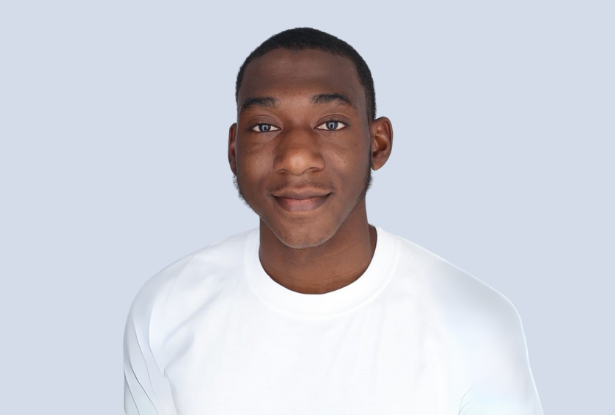Kean Student Researcher Q&A: Ahad Shabazz-Henry

Ahad Shabazz-Henry
Ahad Shabazz-Henry is a senior in the five-year biotechnology B.S./M.S. program in the School of Integrative Science and Technology. He has conducted research for four years in the Niepielko Lab at Kean, served as a visiting research scientist at Princeton University, and presented at international conferences. A Newark resident, he received the Victoria Finnerty Travel Award from the Genetics Society of America and has been selected to represent Natural Sciences as the 2025 Undergraduate Student Researcher of the Year.
Q: What is innovative about your research?
Our research centers around investigating the biological mechanisms that influence reproduction in Drosophila. Specifically, we focus on the biological system of primordial germ cells (PGC). While other forms of research and innovations in the field of fertility aim to increase the succession of fertility between the egg and sperm, our research takes a different approach. We look at the origin/source of fertility (PGC) in hopes of increasing an individual's reproductive capabilities and thus their success rate.
Q: How is your work distinct from your supervisor’s/principal investigator’s?
The work of the Niepielko Lab is a true team effort—a culmination of dedication from hardworking students at both the undergraduate and graduate levels. Despite limited resources and the challenge of balancing busy schedules, our success has been made possible by a strong sense of cooperation and a supportive lab culture. The Niepielko Lab is more than just a research group—it’s a family.
Q: What has been your role so far in developing research ideas and carrying them forward?
Working under Dr. Niepielko has been quite eye-opening, continuously showing me what it means to think and work like a scientist. It has been great to sit in the microscope room, analyze our results and then brainstorm as to what the next steps are. In our research of PGCs, this often feels like an ongoing process of elimination, requiring patience and critical thinking. As upperclassmen in the lab, some of my peers and I have taken on supervisory roles. While conducting our own procedures, we also show the incoming classes in the lab what routine procedures must be done and walk them through the importance of some of our more complex procedures such as immunofluorescence and single molecule fluorescence.
Q: What has been the impact of your research?
Our research focuses on uncovering the unknown regarding the role of PGCs and the mechanisms surrounding their function. In Drosophila, some of our discoveries have revealed that while the process of PGC formation is conserved across different species, evolution has influenced the number, migration and genetic make-up of these granules.
Q: How will this opportunity help you achieve your long-term career plans?
The Research First Initiative at Kean University has provided me with the opportunity to get a head start in my career. Gaining hands-on experience in the lab is essential, as these skills can only be developed through practice over time—they aren’t something you can learn solely through lectures or by taking notes from a textbook. My time in the Niepielko Lab has led to plenty of opportunities. Conducting research at Princeton, presenting at TAGC '24, attending BioNJ '25 are just a few of the experiences that have not only strengthened my interest in pursuing a Ph.D. but have allowed me to connect with fellow students and leaders in my field.
Q: The university is keen to serve the wider (urban) community. Does your planned research have any potential in this area?
Our research aims to address infertility through the analysis of PGCs. In terms of broader impact, our findings could contribute to developing fertility treatments that are more accessible, particularly to urban communities, where studies have shown higher rates of infertility.
Q: How do you balance your time handling research and class work?
Time management can be incredibly challenging for me—as I think it is for most people. Balancing coursework and research is already a lot, but as a student-athlete on Kean's men’s soccer team, I have to divide my time even more carefully, and it can be quite draining. I believe time management has both a physical and mental component. Physically, Apple Calendar has become my best friend. I’m pretty forgetful, so having all my “to-dos” written down on the one thing I always have with me is a lifesaver. Mentally, it can be even tougher. It’s about pushing through the days when you wake up earlier, go to sleep later, travel more, eat a little less and work a little harder to chase your goals. What keeps me going in those moments is my personal ambition because I’ve seen firsthand how hard work and sacrifice can lead to incredible rewards.
Q: Describe a research problem you have faced. What did you learn?
Our lab has faced many obstacles over time, but one experience stands out to me because its lesson extends beyond the lab. We were dealing with a persistent issue in a procedure we routinely perform. Everything in our protocol seemed unchanged, yet the results were consistently off. We spent weeks troubleshooting—methodically eliminating possible causes—until we discovered that the issue was something as simple as expired bleach. In research, it's not uncommon to have to break down entire protocols to fix a problem, and I’ve come to see how this process mirrors life. Sometimes, solving everyday problems requires us to analyze our own habits and make small adjustments. Often, it’s the little things that lead to the biggest changes.